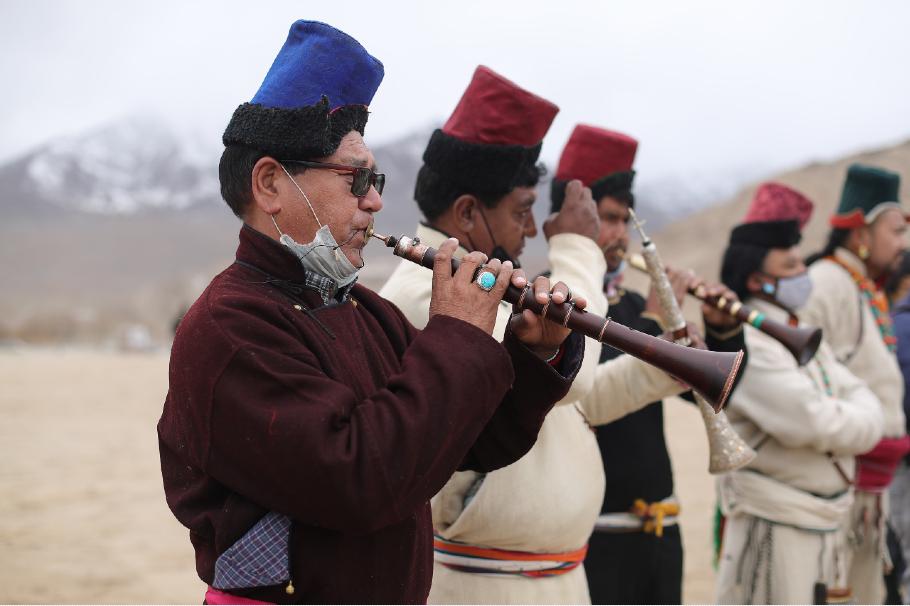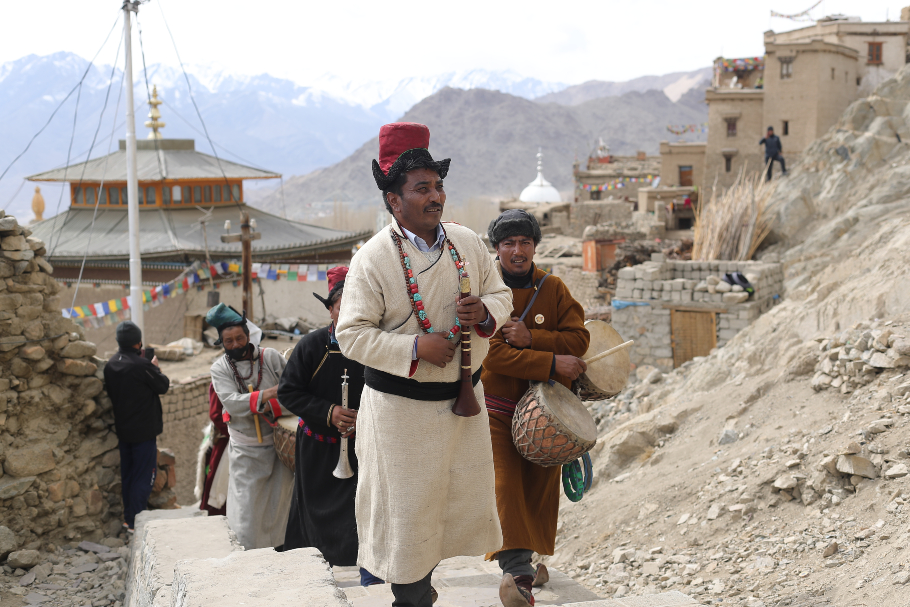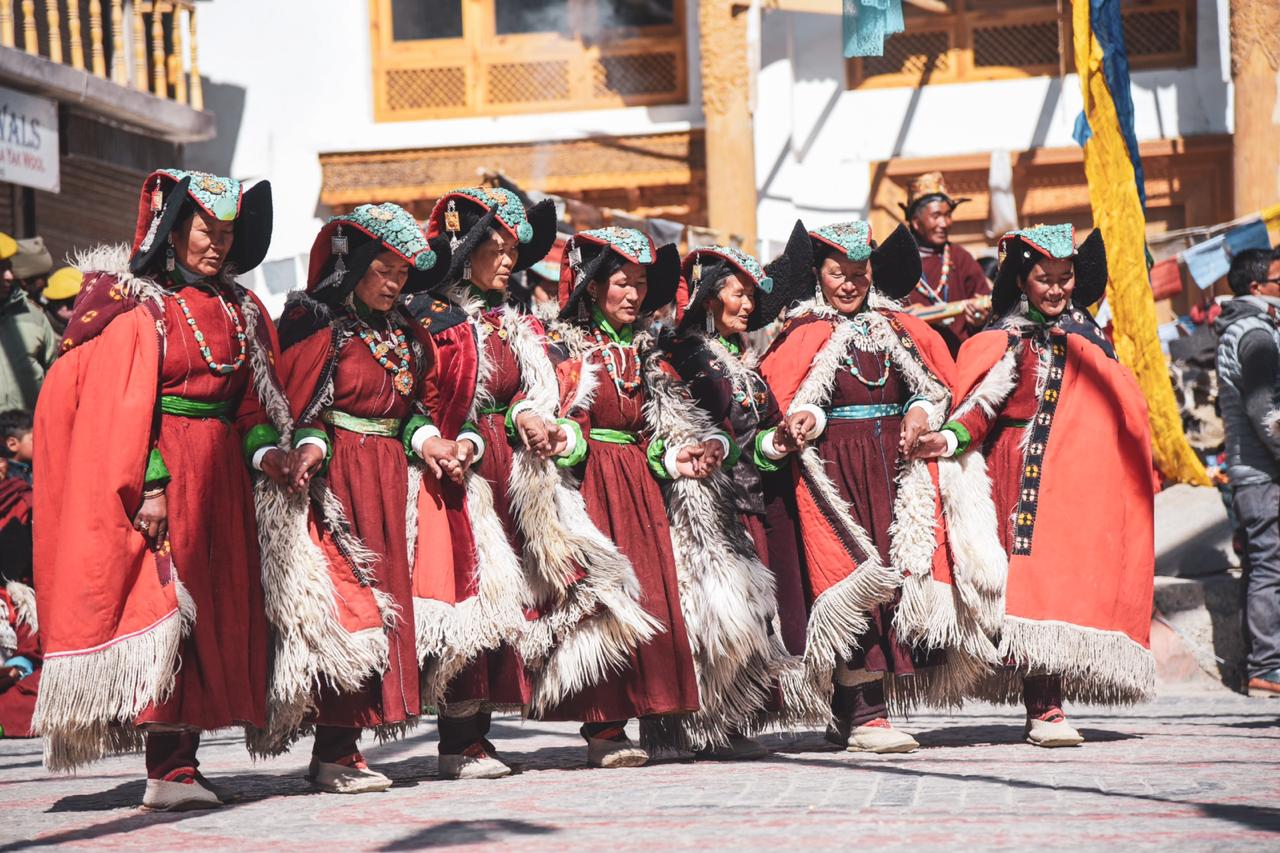
- Home
- News
- Analysis
- States
- Perspective
- Videos
- Education
- Entertainment
- Elections
- World Cup 2023
- Features
- Health
- Budget 2024-25
- Business
- Series
- NEET TANGLE
- Economy Series
- Earth Day
- Kashmir’s Frozen Turbulence
- India@75
- The legend of Ramjanmabhoomi
- Liberalisation@30
- How to tame a dragon
- Celebrating biodiversity
- Farm Matters
- 50 days of solitude
- Bringing Migrants Home
- Budget 2020
- Jharkhand Votes
- The Federal Investigates
- The Federal Impact
- Vanishing Sand
- Gandhi @ 150
- Andhra Today
- Field report
- Operation Gulmarg
- Pandemic @1 Mn in India
- The Federal Year-End
- The Zero Year
- Premium
- Science
- Brand studio
- Home
- NewsNews
- Analysis
- StatesStates
- PerspectivePerspective
- VideosVideos
- Entertainment
- ElectionsElections
- Sports
- Loading...
Sports - Features
- Budget 2024-25
- BusinessBusiness
- Premium
- Loading...
Premium

How Ladakhi royal musicians got sucked into the vortex of caste system
The caste system found its way to Ladakh, alienating the musical community of Bedas who soon started leaving the profession.

When wars between the kings of Ladakh and Baltistan (now in Pakistan-administered Gilgit Baltistan) from late 16th century till mid-17th century seemed to never end, leaving the two kingdoms with fast depleting resources, the the Balti Shia-Muslim king of Khaplu, Raja Ghazi Mir came up with a solution. He sent a marriage proposal of his daughter, princess Rgyal Khtun to the Buddhist king...
When wars between the kings of Ladakh and Baltistan (now in Pakistan-administered Gilgit Baltistan) from late 16th century till mid-17th century seemed to never end, leaving the two kingdoms with fast depleting resources, the the Balti Shia-Muslim king of Khaplu, Raja Ghazi Mir came up with a solution. He sent a marriage proposal of his daughter, princess Rgyal Khtun to the Buddhist king of Ladakh, Jamyang Namgyal.
Namgyal accepted the proposal even though Mir had a condition that the son born out of the wedlock should be brought up a Muslim. (It is another matter that the son Sengge Namgyal later adopted his father’s religion and rose to be one of the powerful kings of Ladakh.)
So, sometime in the 17th century, in a grand ceremony, princess Rgyal Khtun married king Jamyang Namgyal, and the relationship sealed the peace for generations in the region.
But when the princess moved to Ladakh, she brought with her an entourage, which as per the Balti customs, comprised religious preachers, the bride’s friends, agriculturists, artisans, horticulturists, masons, carpenters and musicians.
Low caste tag
The musicians known as Kharmouns (royal musicians) were Balti Muslims, and were experts in playing Surna (Shehnai) and Daman (Ladakhi Drum).
Interestingly, the Surna came from the Mughal courts in Delhi/Agra. In Ladakh, marriages not only happened across faiths, but also across communities as well.
As per oral history, one of the daughters of emperor Jahangir was married to a Balti Maqppon prince of Baltistan. The marriage led to the exchange of customs, traditions from the Mughal court to Baltistan. Among these were some musical instruments like Surna (Shehnai).
The kinship under the Namgyal kings continued for three and a half centuries in Ladakh. Customs and social traditions evolved with the passage of time.
One of the practices under the Namgyal kings was how the royal members were seated in the court. The minister and the king’s family would be seated near the king and the musicians would be at the last. One of the reasons for this was the high sound frequency of the musical instruments, which could be uncomfortable for the king.
While this is believed to be the royal protocol of the time, it seems to have had a profound impact on the musicians, who were largely from the Beda community. They soon began to be considered low caste and faced social alienation.

“Whenever food was served to the Bedas at any social event, clothes were used instead of utensils,” says Ali Mohammad, who has been considered an ambassador of Ladakhi folk music for over 50 years, having been associated as a musician with the All India Radio, Leh, and taught music to scores of students.
“The majority community did not take our daughters as brides,” he rues, adding that caste related discrimination became so intense against the Bedas that it forced many to leave the profession.
Education and better opportunities
Padma Shri Morup Namgyal, who is known across Ladakh for his philanthropic works, particularly in collecting and documenting more than 1,500 folk songs across Ladakh, however, has a slightly different story to tell.
He says that neither Buddhism nor Islam or any other religion practised in Baltistan and Ladakh promoted caste system. However, over the years, the social setup was constructed in such a way that the caste system became a major element of Ladakhi society.
Morup, a contemporary and colleague of Ali Mohammad at AIR Leh, says that under the rule of Gyapo Jamyang Namgyal, traditional music reached its zenith.
He says the Bedas, who were required to play music praising the king or the Llamas (head priests of monasteries), were given land in Phyang village. From Pyhang, they were assigned to different villages and monasteries of Ladakh, due to which they reached to every nook and corner of Ladakh and spread their music.
After Independence, education became compulsory in Ladakh and Bedas (musicians) started educating their children too.
“Education slowly changed their lifestyle, attitude and economy. Bedas were now joining the army, getting higher posts in the administration, and generation after generation, their kids were getting educated and gaining better economic avenues. Therefore, the youths did not continue their ancestral profession.”
Morup says that the royal seating system was actually a practice in the courts of Balti kings, especially Ali Sher Khan Anchan, the Maqpoon king of Baltistan.
The king of Ladakh, Jamyang Namgyal also established this system after the arrival of royal musicians from Baltistan with the princess Rgyal Khatun. The system turned harsh for the Bedas as they began to be considered lower caste.
Religious restrictions
Ali Mohammad also adds that the Bedas being Muslims, came under religious restrictions by clerics, which may have played a role in many leaving the profession.
“Several clerics personally asked me to leave music but a reputed cleric allowed me to continue on a condition. That it is a source of my living,” Ali says.
Ahmad Jawan, a Shina poet, musician and cultural activist from Drass, says Douns (musician in Shina language) were a major element of his community. But in 20th century, due to the proximity of the tribe with Islam, they were ill-treated due to their profession and caste, which forced Douns left the profession in Drass.

Jawan and his father learned music as a passion as they were not from the lineage of Douns. His father got a job as a musician in Doordarshan, Srinagar. However, he says that people often misjudge him, linking to the Doun community.
“I have seen people from the musical community getting largely marginalised, which people do not admit openly,” he says.
As per Jawan, by the late 70’s Douns (musicians) had distanced themselves from any sort of musical activity and no Doun musician was left in Drass.
“You can hardly find such musicians. The reasons are religious, as Islam does not allow music. However, social alienation cannot be totally nullified,” he says.
British policy to further caste divisions
Over the centuries, Ladakh’s social history has been shaped by events such as colonial times, Dogra oppression and then a democratic setup under the government of India.
During the early 20th century, the seeds of caste-based practices and influences were sown in the Ladakhi society, primarily by the British, as they found the system convenient to divide and rule the large mass of people.
Tashi Morup founder of Leh based Arts and Media organisation LAMO, says caste-related differences were not a major norm from 17th to early 19th century (Namgyal period in Leh and Gasho period in Kargil). The system was existent but not brutally practised.
He believes that the colonialists exploited the problem.
“It has definite imprints of colonialist oppression, which the common Ladakhis and majority of the researchers do not know. British used it as a tool of oppression to divide the community on the lines of caste. The people were ignorant as to how it got prevalent and also did not know the ramifications. However, it was heavily propagated between the early 20th or late 19th century,” says Tashi who made a documentary film on the musical trends of Ladakh.
He says that unnecessary administrative divisions happened in Ladakh during the British time between Leh and Kargil, ignoring the fact that ethnically and custom-wise, they were one people.
“The British created administrative units such Leh, Kargil and Skardu Tehsils, which complicated the issues; seeds of division were sown; there was no united voice, and slowly a void appeared amongst the community which is still visible.”
Change rings through the air
“But all of such things have now reduced largely,” says Ali Mohammad. “Now people respect and treat us with honour. The society now respects, accepts and acknowledges the community (Bedas) due to the spread of education. Youths from non-musical families now are coming to me to learn music.”
“Many religious and social organisations of Ladakh have stressed me to teach Tongpas to create equality and by doing so music will not remain confined to a particular tribe and caste prejudices will slowly get reduced,” he says.

Ali has broken stereotypes of his community by training hundreds of aspiring music lovers and believes his students will form the basis of a Ladakh where caste system will not exist.
He also says that there are female Ghazal singers from the Muslim community as well. His own daughter is a Balti ghazal singer.
Rigzin Sheshan president youth wing, Ladakh Buddhist Association (LBA), says that Ladakhis need to understand the fact that the Bedas came with the Queen Rgyal Khatun as royal musicians of Ladakhi kings, not as an ordinary, downtrodden low caste community, which is the present perspective. He says the same for the Garbas (blacksmiths), as their job was to make war equipment for the royal army.
“In last 70 years, the caste system has so much seeped into our roots that Bedas, Moun (migrant musicians) and Garbas were marginalised.”
Sheshan believes that a modern educated Ladakhi will not believe in these customs, and now people should accept them as artists and their skill as an art form, which has not been the case.
According to Sheshan, Ambedkar is a role model for youths like him to deal with caste system but he also acknowledges that a religious or social organisation cannot completely eradicate the caste system.
He is optimistic that the caste system will not remain relevant in the coming generations, as according to him due to education and presence of new generation things are changing and will change for sure in future as well.
Morup Namgyal says that although caste-related issues have reduced against the musical communities, still no one will go to them with a proposal for a wedding.
Namgyal has argued for non-Bedas to also learn traditional music to reduce the caste system and preserve this rare art, and along with his friends, has organised music workshops.
“The major objective was that in every village, at least 6-7 persons are trained.”
His endeavours have received positive responses, as a good number of youths in Leh have trained in traditional Ladakhi music.
However, Namgyal says that unless and until the Bedas improve their educational and economic status, the caste system will persist in Ladakh.
“I have observed that no one dares to discriminate against a rich person despite being of low caste. Contrary to this, a poor man will be the first victim of caste related abuses and partiality.”

